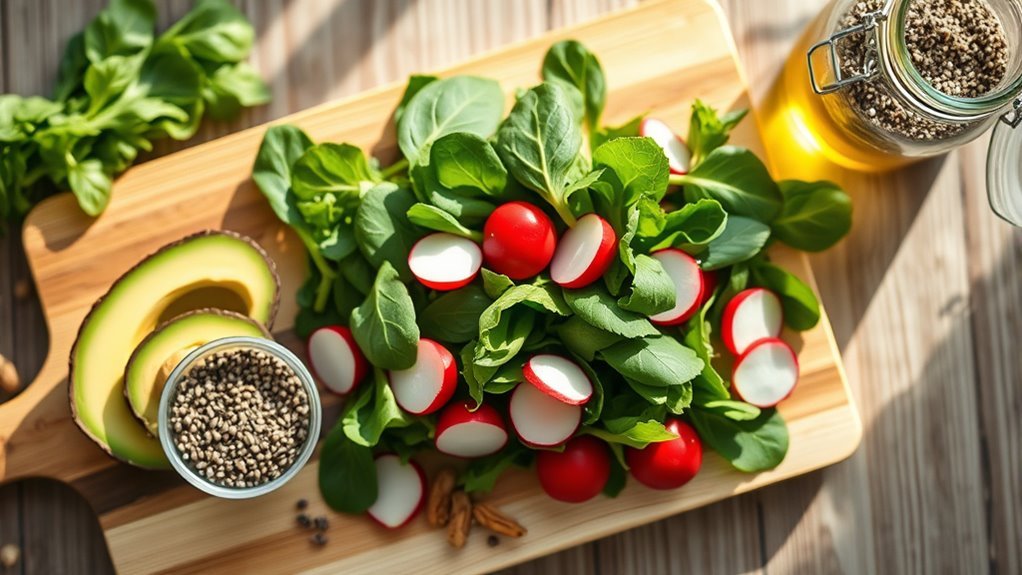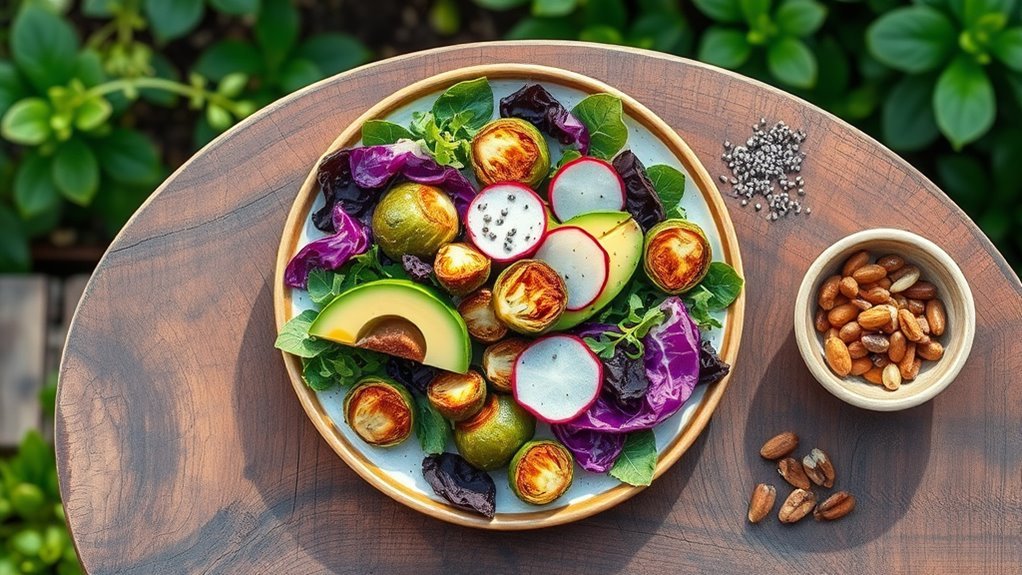To get enough fiber on a keto diet, focus on low-carb vegetables like broccoli and spinach, which provide essential nutrients without the carbs. Nuts and seeds, such as almonds and chia seeds, are also great sources of fiber. Don’t overlook low-carb fruits like raspberries and blackberries for natural sweetness and additional fiber. If you’re struggling to meet your goals, consider fiber supplements. There’s more to explore on maximizing fiber while enjoying your keto lifestyle.
Understanding Fiber and Its Importance on Keto

When you’re on a keto diet, understanding fiber’s role can be essential for achieving your health goals. Fiber types, such as soluble and insoluble fiber, play important roles in promoting gut health. Soluble fiber can help regulate blood sugar levels and improve cholesterol, while insoluble fiber aids in digestion and prevents constipation. On keto, you might be consuming fewer high-fiber foods, so it’s crucial to incorporate sources that fit your dietary needs. Low-carb options like chia seeds, flaxseeds, and avocados can help you meet your fiber intake and support your overall well-being. Additionally, flaxseed’s low carbohydrate content makes it an excellent choice for enhancing your fiber intake while staying within your daily carb limits. Prioritizing fiber not only enhances gut health but also keeps you feeling full, giving you the freedom to enjoy your meals without the guilt of high-carb foods.
Low-Carb Vegetables to Boost Your Fiber Intake

To increase your fiber intake on a keto diet, incorporating low-carb vegetables is essential. These veggies not only provide fiber but also pack in vitamins and minerals that support your overall health. We’ll explore some top fiber-rich options and cooking methods that help preserve their nutritional benefits. Broccoli, for example, is a great addition due to its low carb count and high fiber content, making it perfect for maintaining ketosis.
Top Fiber-Rich Vegetables
Here are some top fiber-rich vegetables to take into account:
- Avocado: High in healthy fats and fiber, it adds creaminess to your meals.
- Broccoli: Packed with vitamins and minerals, it’s a versatile addition to many dishes.
- Spinach: Low in carbs and rich in fiber, it’s great for salads or sautéing. Cabbage, with its low carb count, is another excellent option to include in your keto meals for added fiber.
Cooking Methods for Fiber
Incorporating fiber-rich, low-carb vegetables into your keto diet can be easier than you think, especially when you use the right cooking methods. Steaming vegetables, like broccoli or spinach, preserves their nutrients and enhances their fiber content, making them a fantastic addition to your meals. You can also try roasting nuts, which not only boosts their flavor but also adds healthy fats and fiber to your diet. Just toss them with some olive oil and your favorite spices before popping them in the oven. By focusing on these simple cooking methods, you’ll elevate the fiber in your meals without sacrificing taste or your keto goals. Additionally, incorporating low-carb vegetables like broccoli can help you maintain a balanced intake while enjoying delicious, healthful eating!
Incorporating Nuts and Seeds Into Your Diet

Incorporating nuts and seeds into your keto diet is a smart way to boost your fiber intake. Almonds, walnuts, and chia seeds are excellent options that not only provide healthy fats but also deliver essential fiber. By adding these nutrient-dense foods, you can enhance both your fiber levels and overall nutrition. Additionally, choosing low-carb options like macadamia nuts and pecans ensures you stay within your carbohydrate limits while enjoying a variety of flavors.
Nut Varieties for Keto
Nuts and seeds are excellent additions to a keto diet, providing not only healthy fats but also essential fiber. Incorporating different nut varieties can enhance your nut health while keeping your carb intake low. Here are some top choices for your keto journey:
- Almonds: High in fiber and vitamin E, they make a great snack. They are also low in carbohydrates, making them ideal for maintaining ketosis.
- Walnuts: Rich in omega-3 fatty acids and beneficial for heart health.
- Pecans: Low in carbs and a fantastic source of healthy fats.
Seed Options for Fiber
When it comes to boosting fiber intake on a keto diet, seeds can play an essential role alongside nuts. Incorporating chia seeds, flax seeds, and hemp seeds into your meals can greatly increase your fiber content. Chia seeds, for example, are packed with omega-3 fatty acids and can absorb water, creating a gel-like substance that aids digestion. Flax seeds offer lignans and soluble fiber, while hemp seeds provide a complete protein profile. Don’t forget about pumpkin seeds and sunflower seeds; they’re not only crunchy and satisfying but also rich in fiber and healthy fats. Sesame seeds, too, can be sprinkled on salads or incorporated into dressings for added texture and nutrition. Additionally, incorporating nuts like pecans, which are high in healthy fats, can enhance your fiber intake while supporting your keto goals. Enjoy experimenting with these seeds to enhance your keto journey!
Exploring Low-Carb Fruits for Fiber
Although the keto diet is often associated with strict carbohydrate limits, you can still enjoy certain low-carb fruits that provide essential fiber. Incorporating these keto-friendly options can help you maintain your fiber intake while staying within your carb goals.
Consider adding these low-carb fruits to your diet:
- Raspberries: Packed with fiber, they contain only 5 grams of net carbs per cup.
- Blackberries: Another excellent choice, with about 6 grams of net carbs per cup.
- Strawberries: Delicious and versatile, with approximately 8 grams of net carbs per cup. Additionally, including berries in your diet can enhance your overall health with antioxidants and vitamins.
Fiber Supplements and Their Role in a Keto Diet
While following a keto diet, you might find it challenging to meet your fiber needs through food alone, which is where fiber supplements can play an essential role. There are various fiber supplement types, including psyllium husk, inulin, and chia seeds, each offering unique benefits. Adding these to your routine can help you achieve your daily fiber intake without compromising your carb limit. For effective fiber absorption, consider taking supplements with plenty of water, as this aids digestion and reduces potential bloating. It’s also beneficial to gradually increase your fiber intake to allow your body to adjust. By incorporating the right fiber supplements, you can enjoy the freedom of a keto lifestyle while maintaining digestive health. Additionally, incorporating keto-friendly vegetables like carrots can provide natural fiber while adding essential nutrients to your diet.
Meal Ideas to Maximize Fiber While Staying Keto
To maximize fiber intake on a keto diet, you’ll want to focus on incorporating low-carb, high-fiber foods into your meals. Fiber meal prepping can be a game-changer, allowing you to stay on track while enjoying delicious, keto-friendly recipes. Here are some meal ideas to help you boost your fiber:
- Chia Seed Pudding: Mix chia seeds with almond milk and your favorite keto-friendly sweetener for a fiber-rich breakfast. Chia seeds have a high fiber content that can aid digestion and support weight management on a keto diet.
- Zucchini Noodles: Toss spiralized zucchini with pesto and grilled chicken for a satisfying lunch packed with fiber.
- Avocado Salad: Combine diced avocado, spinach, and nuts for a fiber-loaded side dish that’s easy to prepare.
With these ideas, you can enjoy a variety of meals while maximizing your fiber intake on a keto diet.
Frequently Asked Questions
Can I Get Enough Fiber Without Eating Vegetables?
Absolutely, you can! If you’re skipping veggies, consider low carb fruits like berries—blueberries and raspberries are great options. They pack a fiber punch while keeping carbs low. Fiber supplements can also be your friend; look for options like psyllium husk or acacia fiber. They’re convenient and can help maintain digestive health. Remember, finding fiber freedom is possible without a plateful of greens; just get creative with your choices!
How Do I Track My Fiber Intake on Keto?
To track your fiber intake on keto, you can use a keto calculator that allows you to log your food. Start by entering the foods you eat to see their fiber content. Many apps also provide a breakdown of net carbs and fiber, making it easier to stay within your limits. Don’t forget to check labels, too; they often list dietary fiber, helping you keep your fiber tracking accurate and effortless.
Are There Any Fiber-Rich Keto Snacks?
Yes, there are fiber-rich keto snacks you can enjoy! Consider incorporating keto-friendly nuts like almonds and chia seeds, which are great sources of fiber. You might also want to try fiber supplements if you’re struggling to meet your daily intake. Foods like avocados and flaxseeds can add some fiber too. Just make sure to check the carb count, so you stay within your limits while enjoying your snacks!
What Are the Side Effects of Low Fiber on Keto?
Did you know that around 25% of people on low-fiber diets experience constipation? If you’re not getting enough fiber on keto, you might face digestive health issues like constipation, bloating, and discomfort. To counteract this, consider incorporating constipation remedies such as low-carb vegetables or psyllium husk. Staying hydrated and prioritizing gut-friendly foods can help maintain your digestive balance, giving you the freedom to enjoy your keto journey without discomfort.
Can I Exceed My Fiber Intake on a Keto Diet?
Yes, you can exceed your fiber intake on a keto diet, but it’s important to maintain a balance. While fiber is essential for digestion and overall health, too much can lead to discomfort like bloating. Aim for a variety of low-carb, high-fiber foods to meet your needs without going overboard. Listen to your body, and adjust accordingly to find that sweet spot where you feel your best while enjoying the freedom of your diet.


